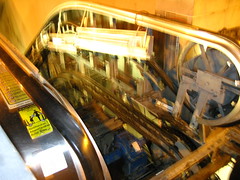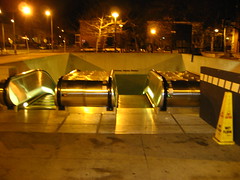 One thing every resident of DC who uses the Metro system contends with are the escalators.
One thing every resident of DC who uses the Metro system contends with are the escalators.
And yes, I do mean “contends.”
You see, when the Metro system was planned in the 1970s, the usual governmental contract bid philosophy took hold: use the lowest bidder. In other words: go cheap.
And given the other shortcomings of the system – only two tracks on each line, unreliable and weather-vulnerable train equipment, lame-ass voice announcement recordings, inefficient seating design – the thing that seems to catch more riders than anything else are the are-they-or-aren’t-they-working escalators at stations.
These escalators, word has it, were contracted to a company that had never before built such equipment. But hey, the cost was cheap, so why not? The problem is that, given no experience in building escalators, the manufacturer didn’t design them for things that are common in the Metro system:
- long stair runs
- heavy loads
- adverse weather
 So more often than not, one or more escalators are out of commission, forcing riders onto either a single working unit, or onto a single unit that is stopped because its neighbors are both out. When I snapped this photo, the stair on the left had only recently reopened – earlier, it was also being serviced, making the center unit a stationary stairway.
So more often than not, one or more escalators are out of commission, forcing riders onto either a single working unit, or onto a single unit that is stopped because its neighbors are both out. When I snapped this photo, the stair on the left had only recently reopened – earlier, it was also being serviced, making the center unit a stationary stairway.
And at stations like Dupont Circle, Tenleytown, or Wheaton – all of which are deep underground and thus have long runs of stairs – it can be a long slog up the stairs after a day at the office, afternoon shopping, or a night on the town. In some respects it reminds me of the stairs at the Covent Garden Station on the London Underground:
Never ever, under any circumstances, take the stairs. Don’t do it because although you think it might be quicker than waiting for the lift: it won’t be, and the ascent will destroy you. There are 193 steps, and that’s the equivalent of climbing to the top of a 15-storey building. The only sensible way to tackle the Covent Garden staircase is from the top down. It’s enormously satisfying to trip nimbly past a succession of hapless souls stumbling breathlessly upwards, especially those with the added misfortune to be carrying heavy shopping. (from Time Out London)
And while there are also elevators at all stations (which have their own dubious reliability record), the escalators are the primary means of access to the Metro.













Comments by randomduck
virtual advent 2020: a fab holiday (and it’s been 40 years…)
@compassionknit: I think the issue is that John had Julian ...
ten on tuesday: the music died too young
Good call on those three!
my 30s: a look back
Thanks, Darren and Jeff! Jeff, riding along the California coast with ...